System Thinking
VerifiedAdded on 2023/05/30
|14
|2739
|146
AI Summary
This report conducted a study over a given hypothetical State value stream map and uses System thinking the approach to identify the key areas or activities that need to be incorporated in order to reduce the waiting time.
Contribute Materials
Your contribution can guide someone’s learning journey. Share your
documents today.
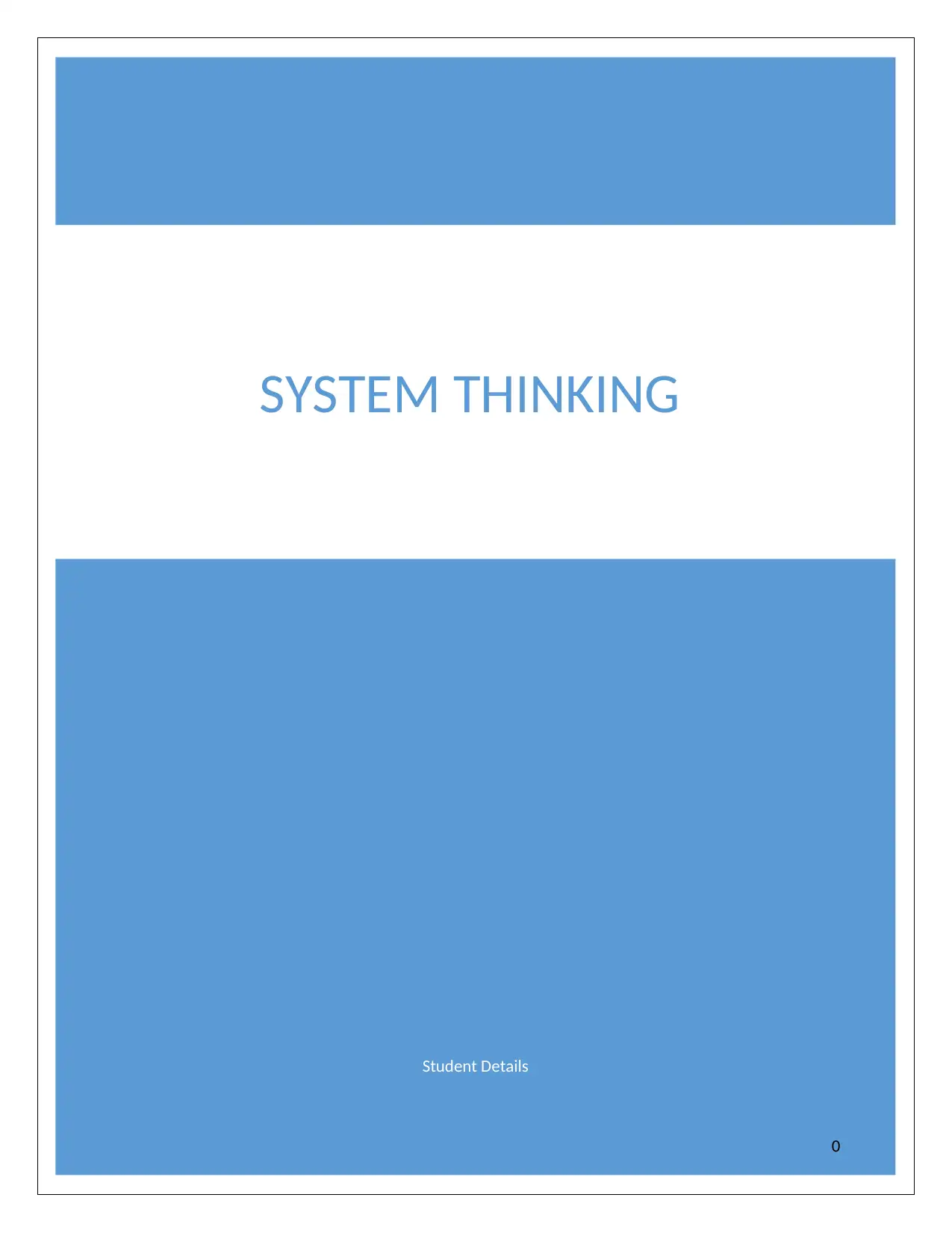
Student Details
SYSTEM THINKING
0
SYSTEM THINKING
0
Secure Best Marks with AI Grader
Need help grading? Try our AI Grader for instant feedback on your assignments.
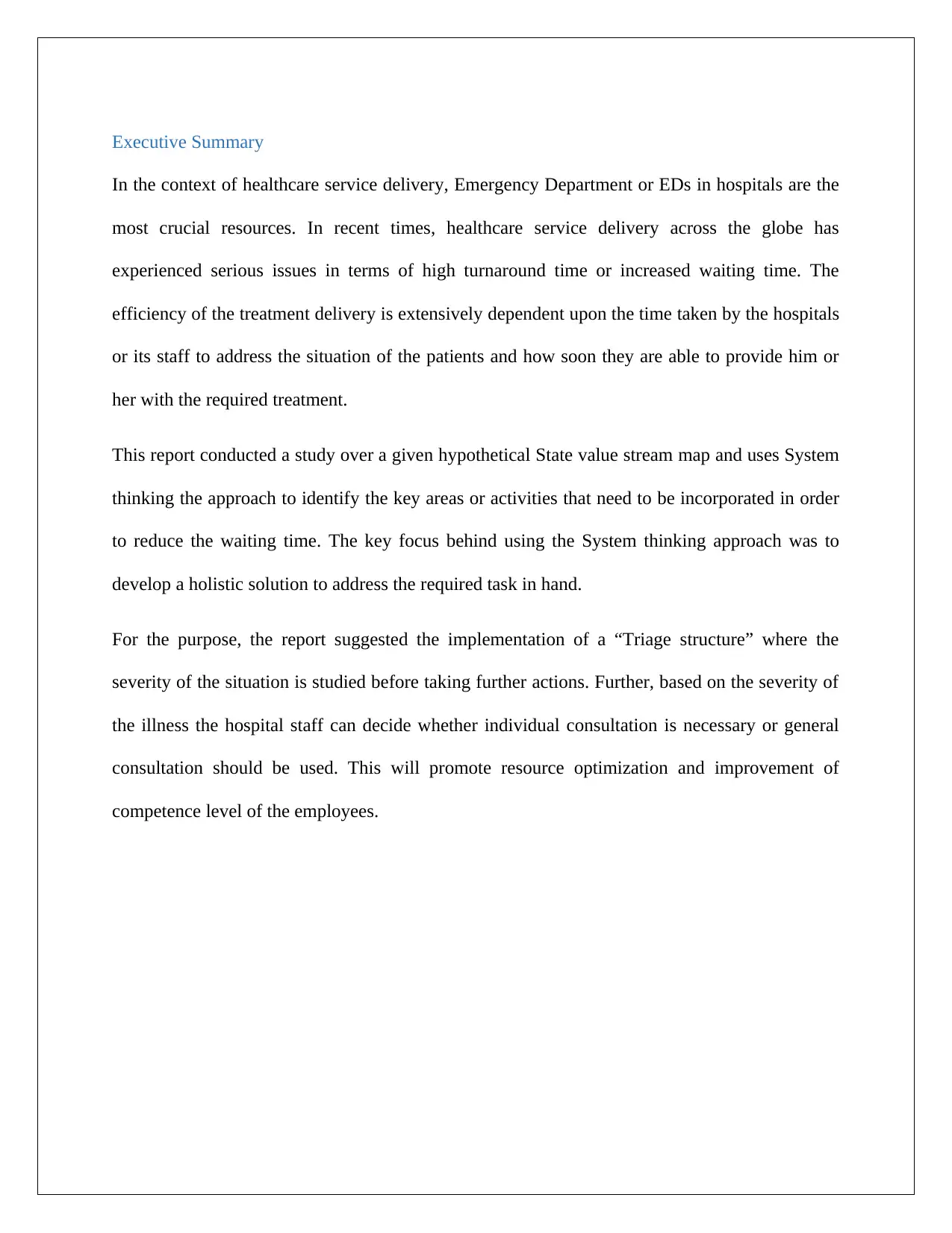
Executive Summary
In the context of healthcare service delivery, Emergency Department or EDs in hospitals are the
most crucial resources. In recent times, healthcare service delivery across the globe has
experienced serious issues in terms of high turnaround time or increased waiting time. The
efficiency of the treatment delivery is extensively dependent upon the time taken by the hospitals
or its staff to address the situation of the patients and how soon they are able to provide him or
her with the required treatment.
This report conducted a study over a given hypothetical State value stream map and uses System
thinking the approach to identify the key areas or activities that need to be incorporated in order
to reduce the waiting time. The key focus behind using the System thinking approach was to
develop a holistic solution to address the required task in hand.
For the purpose, the report suggested the implementation of a “Triage structure” where the
severity of the situation is studied before taking further actions. Further, based on the severity of
the illness the hospital staff can decide whether individual consultation is necessary or general
consultation should be used. This will promote resource optimization and improvement of
competence level of the employees.
In the context of healthcare service delivery, Emergency Department or EDs in hospitals are the
most crucial resources. In recent times, healthcare service delivery across the globe has
experienced serious issues in terms of high turnaround time or increased waiting time. The
efficiency of the treatment delivery is extensively dependent upon the time taken by the hospitals
or its staff to address the situation of the patients and how soon they are able to provide him or
her with the required treatment.
This report conducted a study over a given hypothetical State value stream map and uses System
thinking the approach to identify the key areas or activities that need to be incorporated in order
to reduce the waiting time. The key focus behind using the System thinking approach was to
develop a holistic solution to address the required task in hand.
For the purpose, the report suggested the implementation of a “Triage structure” where the
severity of the situation is studied before taking further actions. Further, based on the severity of
the illness the hospital staff can decide whether individual consultation is necessary or general
consultation should be used. This will promote resource optimization and improvement of
competence level of the employees.
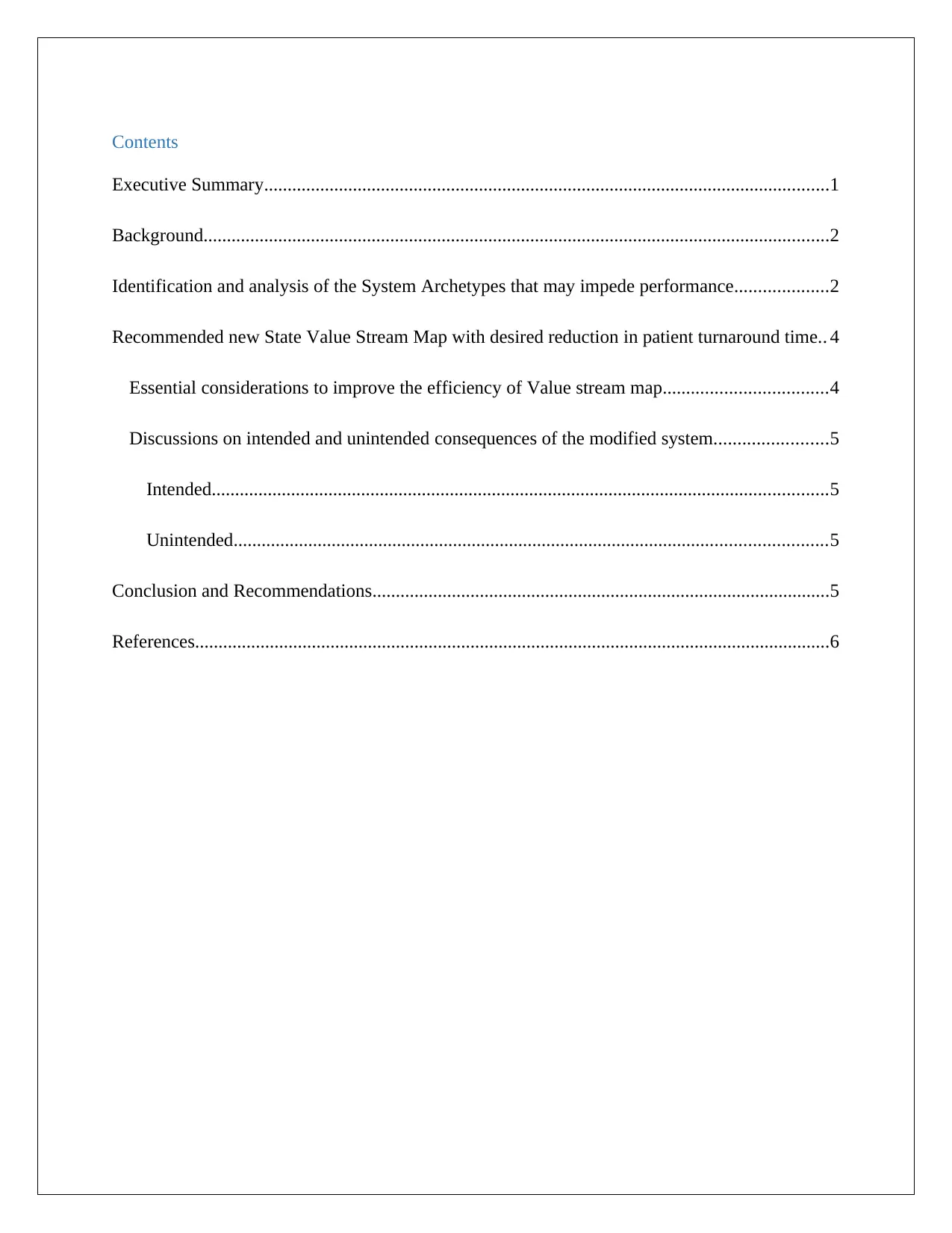
Contents
Executive Summary.........................................................................................................................1
Background......................................................................................................................................2
Identification and analysis of the System Archetypes that may impede performance....................2
Recommended new State Value Stream Map with desired reduction in patient turnaround time.. 4
Essential considerations to improve the efficiency of Value stream map...................................4
Discussions on intended and unintended consequences of the modified system........................5
Intended....................................................................................................................................5
Unintended...............................................................................................................................5
Conclusion and Recommendations..................................................................................................5
References........................................................................................................................................6
Executive Summary.........................................................................................................................1
Background......................................................................................................................................2
Identification and analysis of the System Archetypes that may impede performance....................2
Recommended new State Value Stream Map with desired reduction in patient turnaround time.. 4
Essential considerations to improve the efficiency of Value stream map...................................4
Discussions on intended and unintended consequences of the modified system........................5
Intended....................................................................................................................................5
Unintended...............................................................................................................................5
Conclusion and Recommendations..................................................................................................5
References........................................................................................................................................6
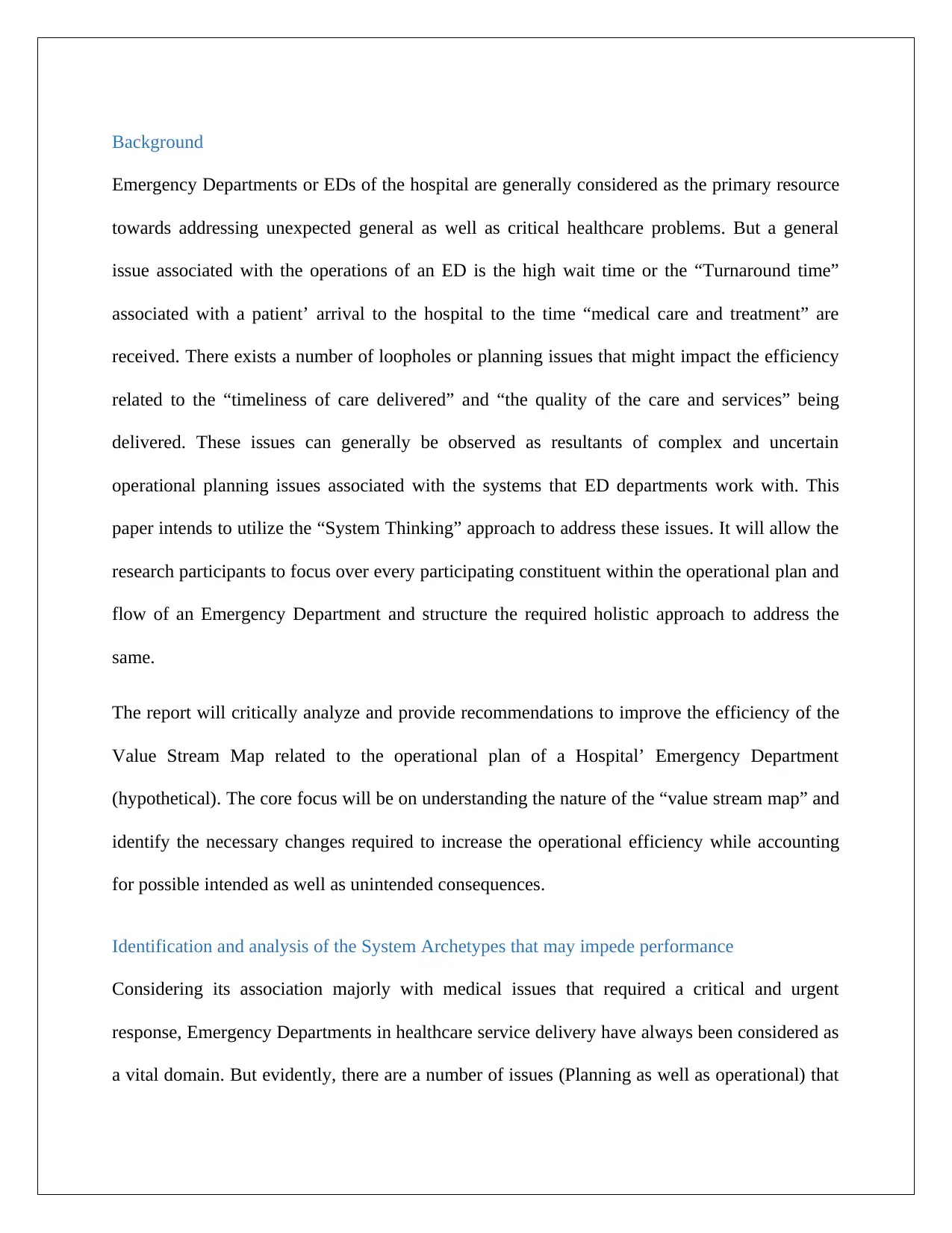
Background
Emergency Departments or EDs of the hospital are generally considered as the primary resource
towards addressing unexpected general as well as critical healthcare problems. But a general
issue associated with the operations of an ED is the high wait time or the “Turnaround time”
associated with a patient’ arrival to the hospital to the time “medical care and treatment” are
received. There exists a number of loopholes or planning issues that might impact the efficiency
related to the “timeliness of care delivered” and “the quality of the care and services” being
delivered. These issues can generally be observed as resultants of complex and uncertain
operational planning issues associated with the systems that ED departments work with. This
paper intends to utilize the “System Thinking” approach to address these issues. It will allow the
research participants to focus over every participating constituent within the operational plan and
flow of an Emergency Department and structure the required holistic approach to address the
same.
The report will critically analyze and provide recommendations to improve the efficiency of the
Value Stream Map related to the operational plan of a Hospital’ Emergency Department
(hypothetical). The core focus will be on understanding the nature of the “value stream map” and
identify the necessary changes required to increase the operational efficiency while accounting
for possible intended as well as unintended consequences.
Identification and analysis of the System Archetypes that may impede performance
Considering its association majorly with medical issues that required a critical and urgent
response, Emergency Departments in healthcare service delivery have always been considered as
a vital domain. But evidently, there are a number of issues (Planning as well as operational) that
Emergency Departments or EDs of the hospital are generally considered as the primary resource
towards addressing unexpected general as well as critical healthcare problems. But a general
issue associated with the operations of an ED is the high wait time or the “Turnaround time”
associated with a patient’ arrival to the hospital to the time “medical care and treatment” are
received. There exists a number of loopholes or planning issues that might impact the efficiency
related to the “timeliness of care delivered” and “the quality of the care and services” being
delivered. These issues can generally be observed as resultants of complex and uncertain
operational planning issues associated with the systems that ED departments work with. This
paper intends to utilize the “System Thinking” approach to address these issues. It will allow the
research participants to focus over every participating constituent within the operational plan and
flow of an Emergency Department and structure the required holistic approach to address the
same.
The report will critically analyze and provide recommendations to improve the efficiency of the
Value Stream Map related to the operational plan of a Hospital’ Emergency Department
(hypothetical). The core focus will be on understanding the nature of the “value stream map” and
identify the necessary changes required to increase the operational efficiency while accounting
for possible intended as well as unintended consequences.
Identification and analysis of the System Archetypes that may impede performance
Considering its association majorly with medical issues that required a critical and urgent
response, Emergency Departments in healthcare service delivery have always been considered as
a vital domain. But evidently, there are a number of issues (Planning as well as operational) that
Secure Best Marks with AI Grader
Need help grading? Try our AI Grader for instant feedback on your assignments.
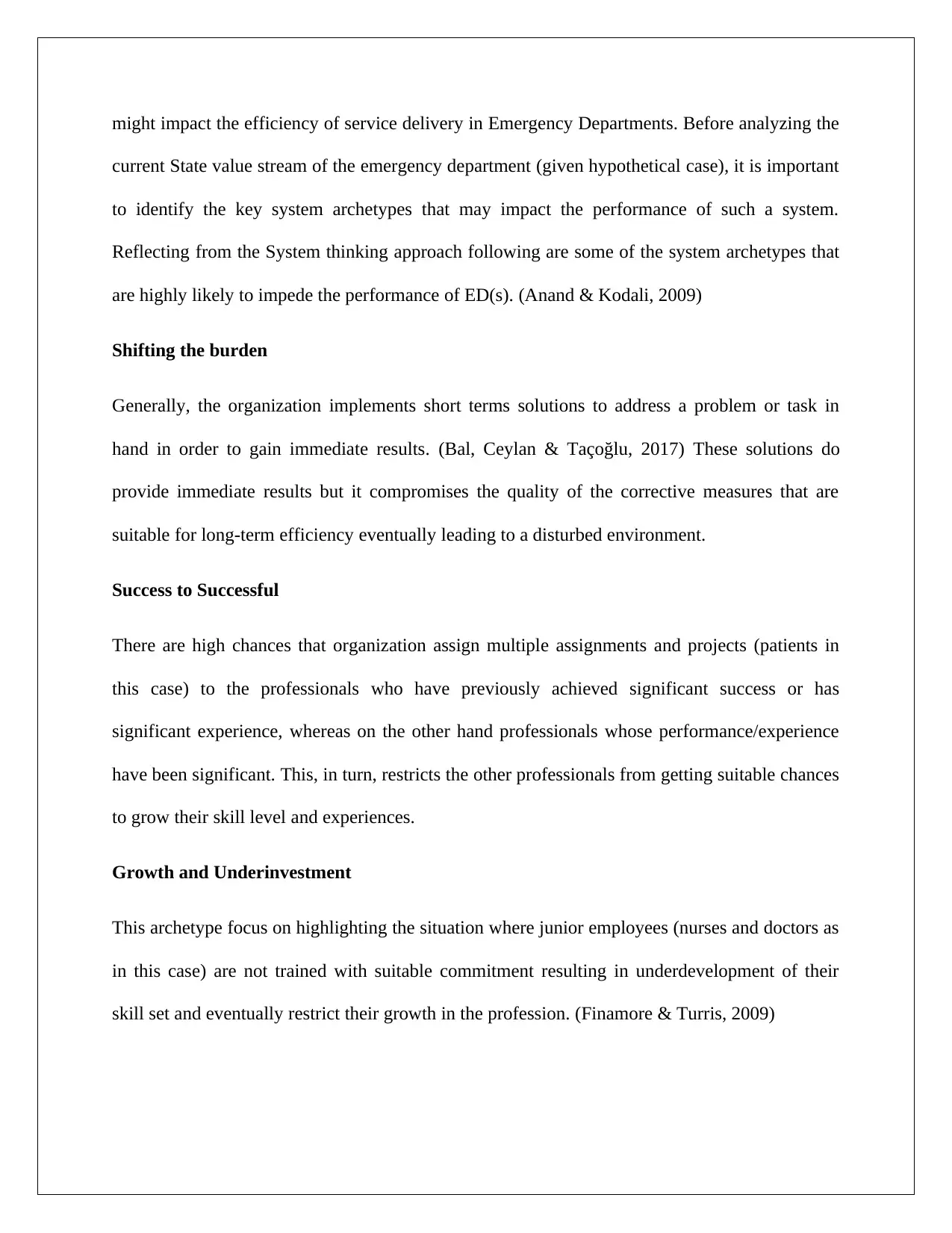
might impact the efficiency of service delivery in Emergency Departments. Before analyzing the
current State value stream of the emergency department (given hypothetical case), it is important
to identify the key system archetypes that may impact the performance of such a system.
Reflecting from the System thinking approach following are some of the system archetypes that
are highly likely to impede the performance of ED(s). (Anand & Kodali, 2009)
Shifting the burden
Generally, the organization implements short terms solutions to address a problem or task in
hand in order to gain immediate results. (Bal, Ceylan & Taçoğlu, 2017) These solutions do
provide immediate results but it compromises the quality of the corrective measures that are
suitable for long-term efficiency eventually leading to a disturbed environment.
Success to Successful
There are high chances that organization assign multiple assignments and projects (patients in
this case) to the professionals who have previously achieved significant success or has
significant experience, whereas on the other hand professionals whose performance/experience
have been significant. This, in turn, restricts the other professionals from getting suitable chances
to grow their skill level and experiences.
Growth and Underinvestment
This archetype focus on highlighting the situation where junior employees (nurses and doctors as
in this case) are not trained with suitable commitment resulting in underdevelopment of their
skill set and eventually restrict their growth in the profession. (Finamore & Turris, 2009)
current State value stream of the emergency department (given hypothetical case), it is important
to identify the key system archetypes that may impact the performance of such a system.
Reflecting from the System thinking approach following are some of the system archetypes that
are highly likely to impede the performance of ED(s). (Anand & Kodali, 2009)
Shifting the burden
Generally, the organization implements short terms solutions to address a problem or task in
hand in order to gain immediate results. (Bal, Ceylan & Taçoğlu, 2017) These solutions do
provide immediate results but it compromises the quality of the corrective measures that are
suitable for long-term efficiency eventually leading to a disturbed environment.
Success to Successful
There are high chances that organization assign multiple assignments and projects (patients in
this case) to the professionals who have previously achieved significant success or has
significant experience, whereas on the other hand professionals whose performance/experience
have been significant. This, in turn, restricts the other professionals from getting suitable chances
to grow their skill level and experiences.
Growth and Underinvestment
This archetype focus on highlighting the situation where junior employees (nurses and doctors as
in this case) are not trained with suitable commitment resulting in underdevelopment of their
skill set and eventually restrict their growth in the profession. (Finamore & Turris, 2009)
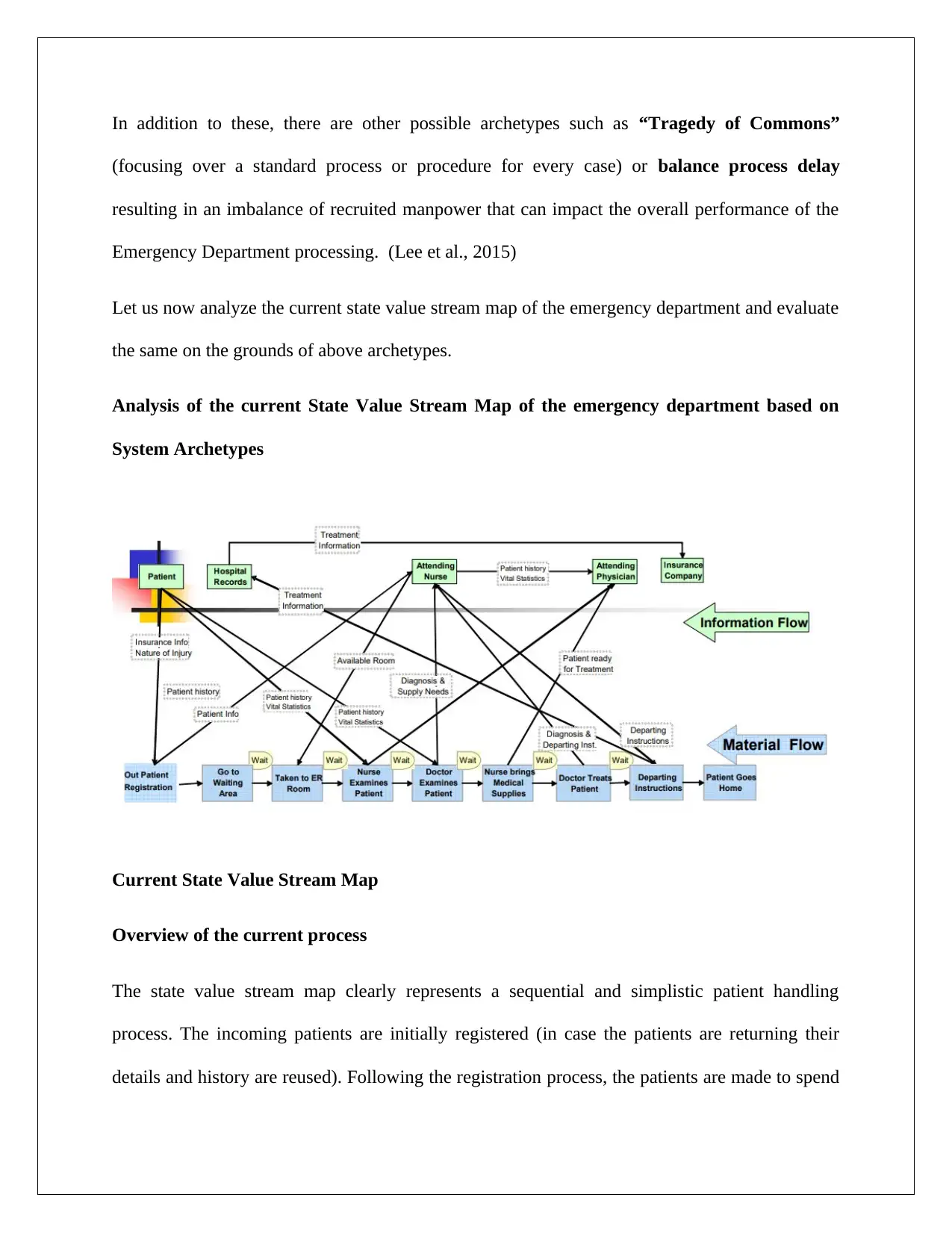
In addition to these, there are other possible archetypes such as “Tragedy of Commons”
(focusing over a standard process or procedure for every case) or balance process delay
resulting in an imbalance of recruited manpower that can impact the overall performance of the
Emergency Department processing. (Lee et al., 2015)
Let us now analyze the current state value stream map of the emergency department and evaluate
the same on the grounds of above archetypes.
Analysis of the current State Value Stream Map of the emergency department based on
System Archetypes
Current State Value Stream Map
Overview of the current process
The state value stream map clearly represents a sequential and simplistic patient handling
process. The incoming patients are initially registered (in case the patients are returning their
details and history are reused). Following the registration process, the patients are made to spend
(focusing over a standard process or procedure for every case) or balance process delay
resulting in an imbalance of recruited manpower that can impact the overall performance of the
Emergency Department processing. (Lee et al., 2015)
Let us now analyze the current state value stream map of the emergency department and evaluate
the same on the grounds of above archetypes.
Analysis of the current State Value Stream Map of the emergency department based on
System Archetypes
Current State Value Stream Map
Overview of the current process
The state value stream map clearly represents a sequential and simplistic patient handling
process. The incoming patients are initially registered (in case the patients are returning their
details and history are reused). Following the registration process, the patients are made to spend
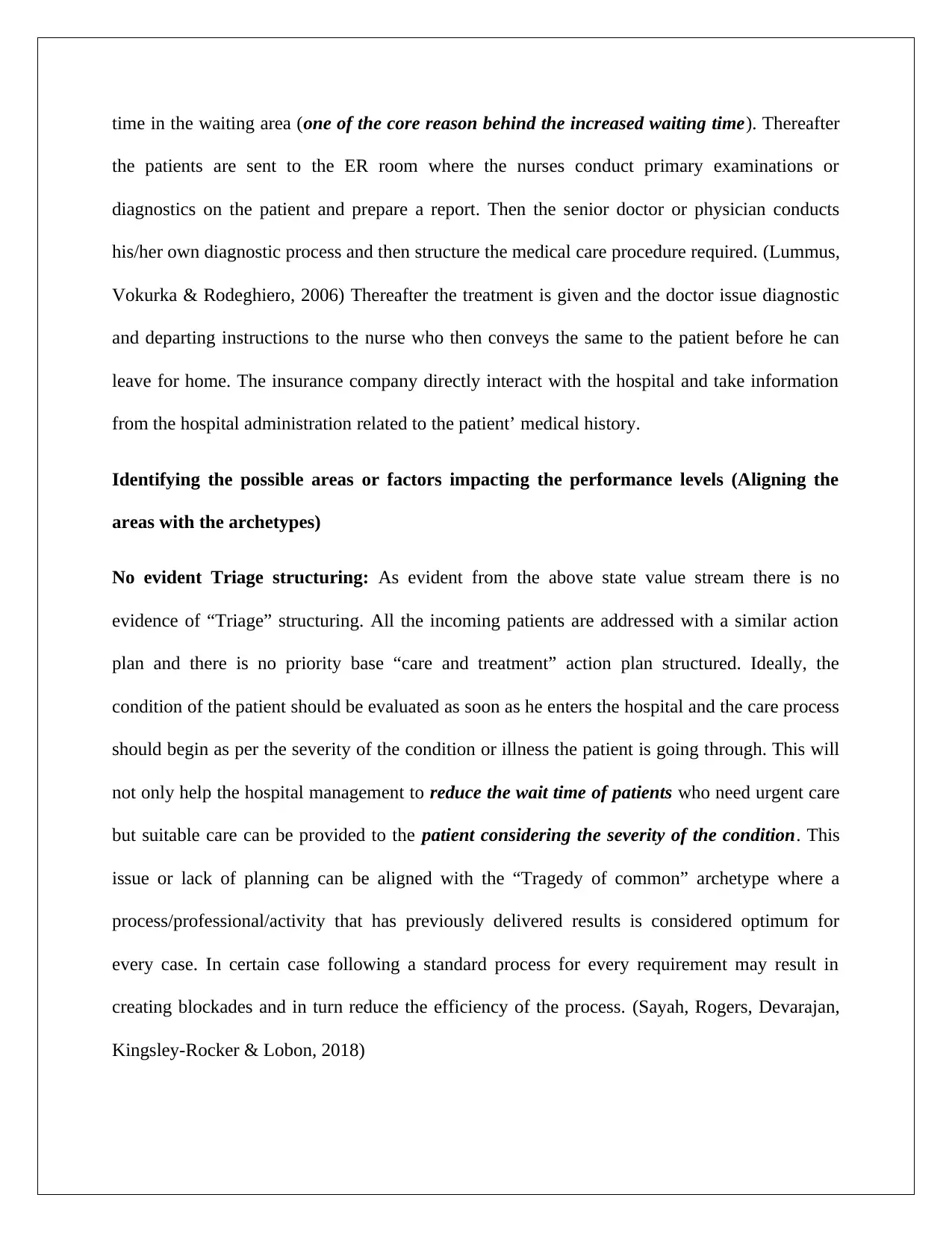
time in the waiting area (one of the core reason behind the increased waiting time). Thereafter
the patients are sent to the ER room where the nurses conduct primary examinations or
diagnostics on the patient and prepare a report. Then the senior doctor or physician conducts
his/her own diagnostic process and then structure the medical care procedure required. (Lummus,
Vokurka & Rodeghiero, 2006) Thereafter the treatment is given and the doctor issue diagnostic
and departing instructions to the nurse who then conveys the same to the patient before he can
leave for home. The insurance company directly interact with the hospital and take information
from the hospital administration related to the patient’ medical history.
Identifying the possible areas or factors impacting the performance levels (Aligning the
areas with the archetypes)
No evident Triage structuring: As evident from the above state value stream there is no
evidence of “Triage” structuring. All the incoming patients are addressed with a similar action
plan and there is no priority base “care and treatment” action plan structured. Ideally, the
condition of the patient should be evaluated as soon as he enters the hospital and the care process
should begin as per the severity of the condition or illness the patient is going through. This will
not only help the hospital management to reduce the wait time of patients who need urgent care
but suitable care can be provided to the patient considering the severity of the condition. This
issue or lack of planning can be aligned with the “Tragedy of common” archetype where a
process/professional/activity that has previously delivered results is considered optimum for
every case. In certain case following a standard process for every requirement may result in
creating blockades and in turn reduce the efficiency of the process. (Sayah, Rogers, Devarajan,
Kingsley-Rocker & Lobon, 2018)
the patients are sent to the ER room where the nurses conduct primary examinations or
diagnostics on the patient and prepare a report. Then the senior doctor or physician conducts
his/her own diagnostic process and then structure the medical care procedure required. (Lummus,
Vokurka & Rodeghiero, 2006) Thereafter the treatment is given and the doctor issue diagnostic
and departing instructions to the nurse who then conveys the same to the patient before he can
leave for home. The insurance company directly interact with the hospital and take information
from the hospital administration related to the patient’ medical history.
Identifying the possible areas or factors impacting the performance levels (Aligning the
areas with the archetypes)
No evident Triage structuring: As evident from the above state value stream there is no
evidence of “Triage” structuring. All the incoming patients are addressed with a similar action
plan and there is no priority base “care and treatment” action plan structured. Ideally, the
condition of the patient should be evaluated as soon as he enters the hospital and the care process
should begin as per the severity of the condition or illness the patient is going through. This will
not only help the hospital management to reduce the wait time of patients who need urgent care
but suitable care can be provided to the patient considering the severity of the condition. This
issue or lack of planning can be aligned with the “Tragedy of common” archetype where a
process/professional/activity that has previously delivered results is considered optimum for
every case. In certain case following a standard process for every requirement may result in
creating blockades and in turn reduce the efficiency of the process. (Sayah, Rogers, Devarajan,
Kingsley-Rocker & Lobon, 2018)
Paraphrase This Document
Need a fresh take? Get an instant paraphrase of this document with our AI Paraphraser

Repetitive efforts: The above process clearly reflect that significant time is wasted when both
the Nurses and the Physician asks the similar kind of questions to the patients. The actual focus
of the value stream map is on shifting the Burden (archetype) of doctors related to the
execution of pre-requisites such as collecting information and detail related to the condition of
the patient. The same case is evident when departing Instructions are given to the patients. The
instructions are initially given to the nurse who then passes to the patient. Significant time can be
saved by creating a direct link between the patient and doctor itself. If the doctor has to evaluate
the condition of the patient himself then there is “no need to conduct primary diagnostics” by the
nurse and the departing instructions can also be given to the patient directly by the doctor. Both
these steps will save time and reduce the turnaround time related to the delivery of care and
treatment to the patient.
Revised State Value Stream Map
the Nurses and the Physician asks the similar kind of questions to the patients. The actual focus
of the value stream map is on shifting the Burden (archetype) of doctors related to the
execution of pre-requisites such as collecting information and detail related to the condition of
the patient. The same case is evident when departing Instructions are given to the patients. The
instructions are initially given to the nurse who then passes to the patient. Significant time can be
saved by creating a direct link between the patient and doctor itself. If the doctor has to evaluate
the condition of the patient himself then there is “no need to conduct primary diagnostics” by the
nurse and the departing instructions can also be given to the patient directly by the doctor. Both
these steps will save time and reduce the turnaround time related to the delivery of care and
treatment to the patient.
Revised State Value Stream Map
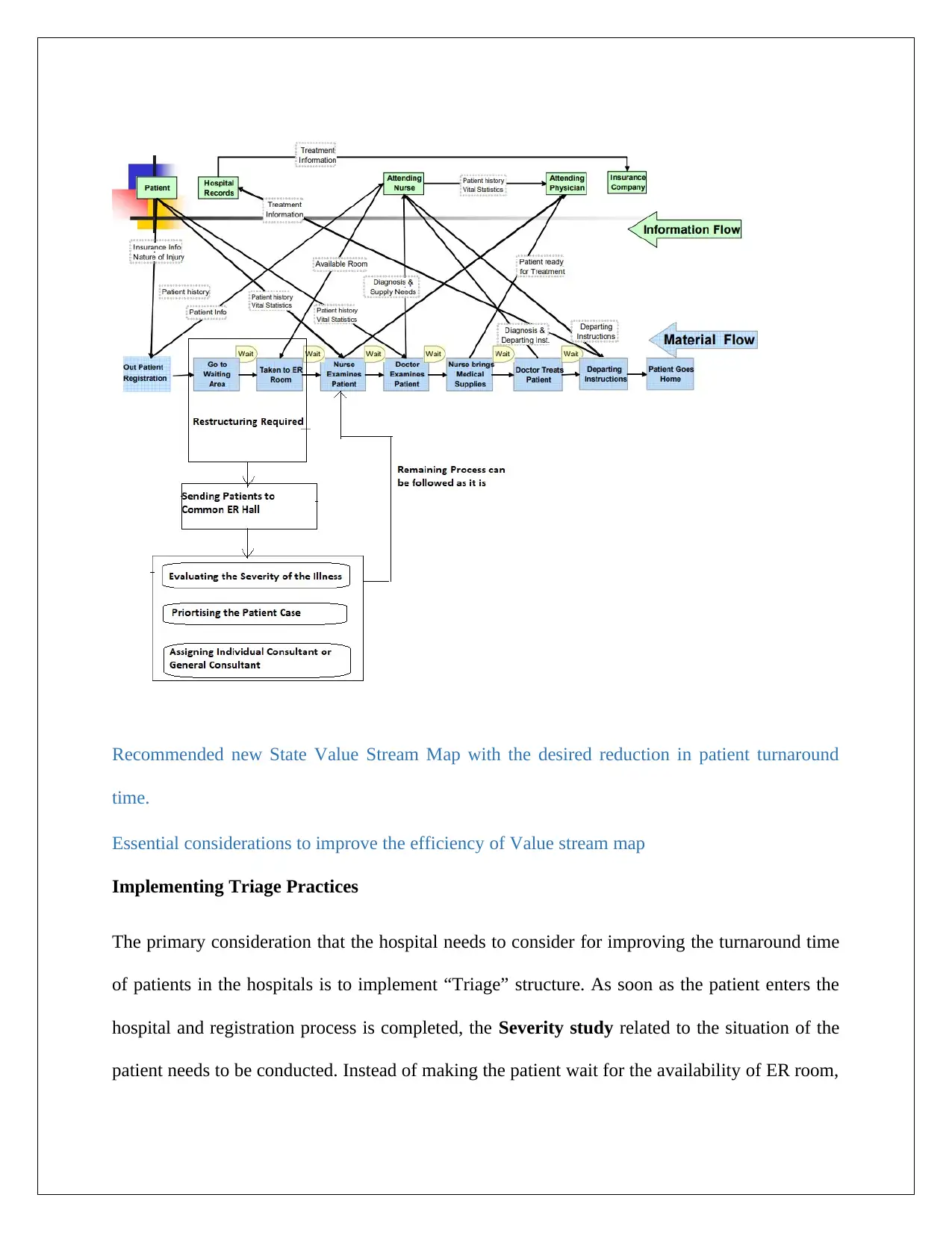
Recommended new State Value Stream Map with the desired reduction in patient turnaround
time.
Essential considerations to improve the efficiency of Value stream map
Implementing Triage Practices
The primary consideration that the hospital needs to consider for improving the turnaround time
of patients in the hospitals is to implement “Triage” structure. As soon as the patient enters the
hospital and registration process is completed, the Severity study related to the situation of the
patient needs to be conducted. Instead of making the patient wait for the availability of ER room,
time.
Essential considerations to improve the efficiency of Value stream map
Implementing Triage Practices
The primary consideration that the hospital needs to consider for improving the turnaround time
of patients in the hospitals is to implement “Triage” structure. As soon as the patient enters the
hospital and registration process is completed, the Severity study related to the situation of the
patient needs to be conducted. Instead of making the patient wait for the availability of ER room,
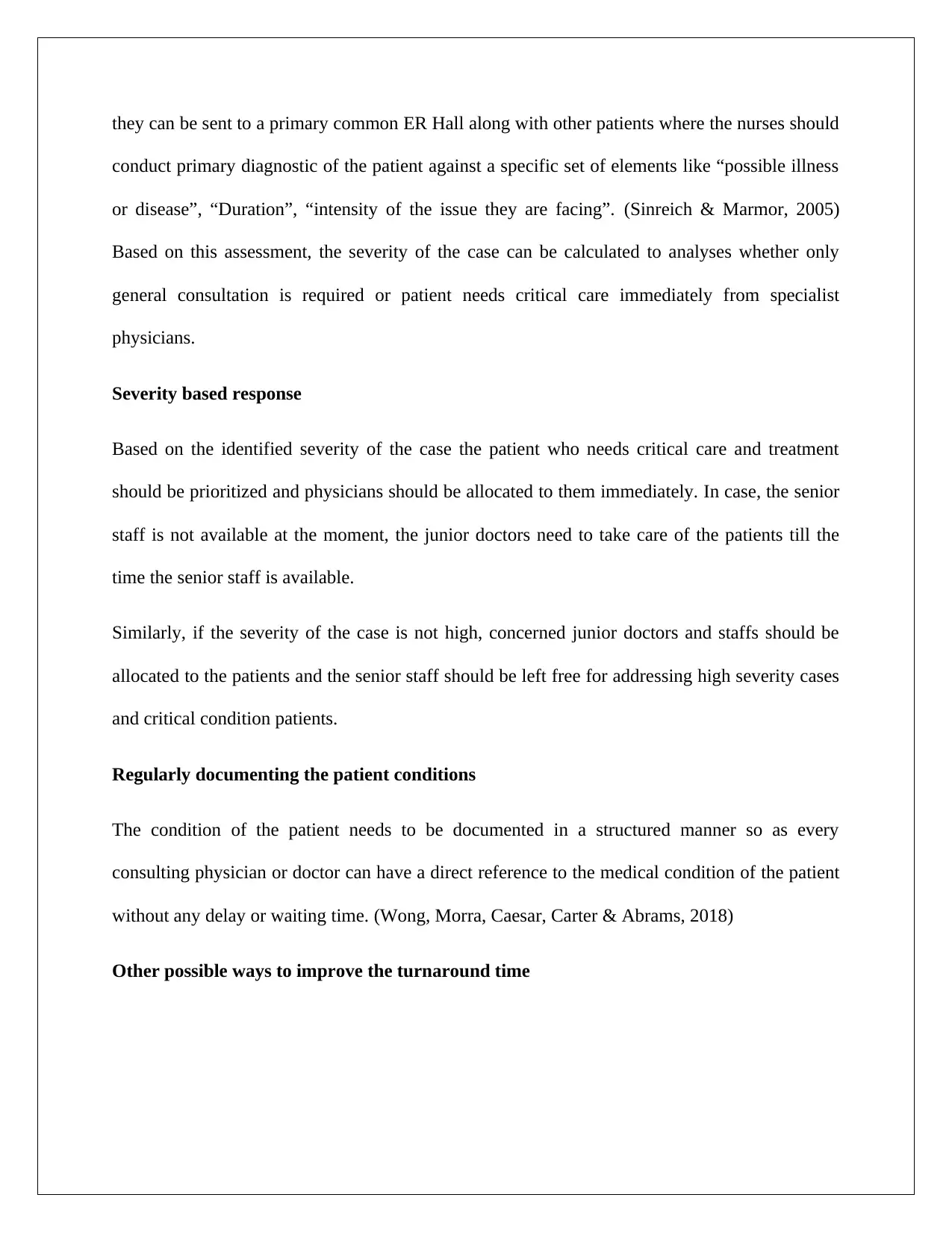
they can be sent to a primary common ER Hall along with other patients where the nurses should
conduct primary diagnostic of the patient against a specific set of elements like “possible illness
or disease”, “Duration”, “intensity of the issue they are facing”. (Sinreich & Marmor, 2005)
Based on this assessment, the severity of the case can be calculated to analyses whether only
general consultation is required or patient needs critical care immediately from specialist
physicians.
Severity based response
Based on the identified severity of the case the patient who needs critical care and treatment
should be prioritized and physicians should be allocated to them immediately. In case, the senior
staff is not available at the moment, the junior doctors need to take care of the patients till the
time the senior staff is available.
Similarly, if the severity of the case is not high, concerned junior doctors and staffs should be
allocated to the patients and the senior staff should be left free for addressing high severity cases
and critical condition patients.
Regularly documenting the patient conditions
The condition of the patient needs to be documented in a structured manner so as every
consulting physician or doctor can have a direct reference to the medical condition of the patient
without any delay or waiting time. (Wong, Morra, Caesar, Carter & Abrams, 2018)
Other possible ways to improve the turnaround time
conduct primary diagnostic of the patient against a specific set of elements like “possible illness
or disease”, “Duration”, “intensity of the issue they are facing”. (Sinreich & Marmor, 2005)
Based on this assessment, the severity of the case can be calculated to analyses whether only
general consultation is required or patient needs critical care immediately from specialist
physicians.
Severity based response
Based on the identified severity of the case the patient who needs critical care and treatment
should be prioritized and physicians should be allocated to them immediately. In case, the senior
staff is not available at the moment, the junior doctors need to take care of the patients till the
time the senior staff is available.
Similarly, if the severity of the case is not high, concerned junior doctors and staffs should be
allocated to the patients and the senior staff should be left free for addressing high severity cases
and critical condition patients.
Regularly documenting the patient conditions
The condition of the patient needs to be documented in a structured manner so as every
consulting physician or doctor can have a direct reference to the medical condition of the patient
without any delay or waiting time. (Wong, Morra, Caesar, Carter & Abrams, 2018)
Other possible ways to improve the turnaround time
Secure Best Marks with AI Grader
Need help grading? Try our AI Grader for instant feedback on your assignments.
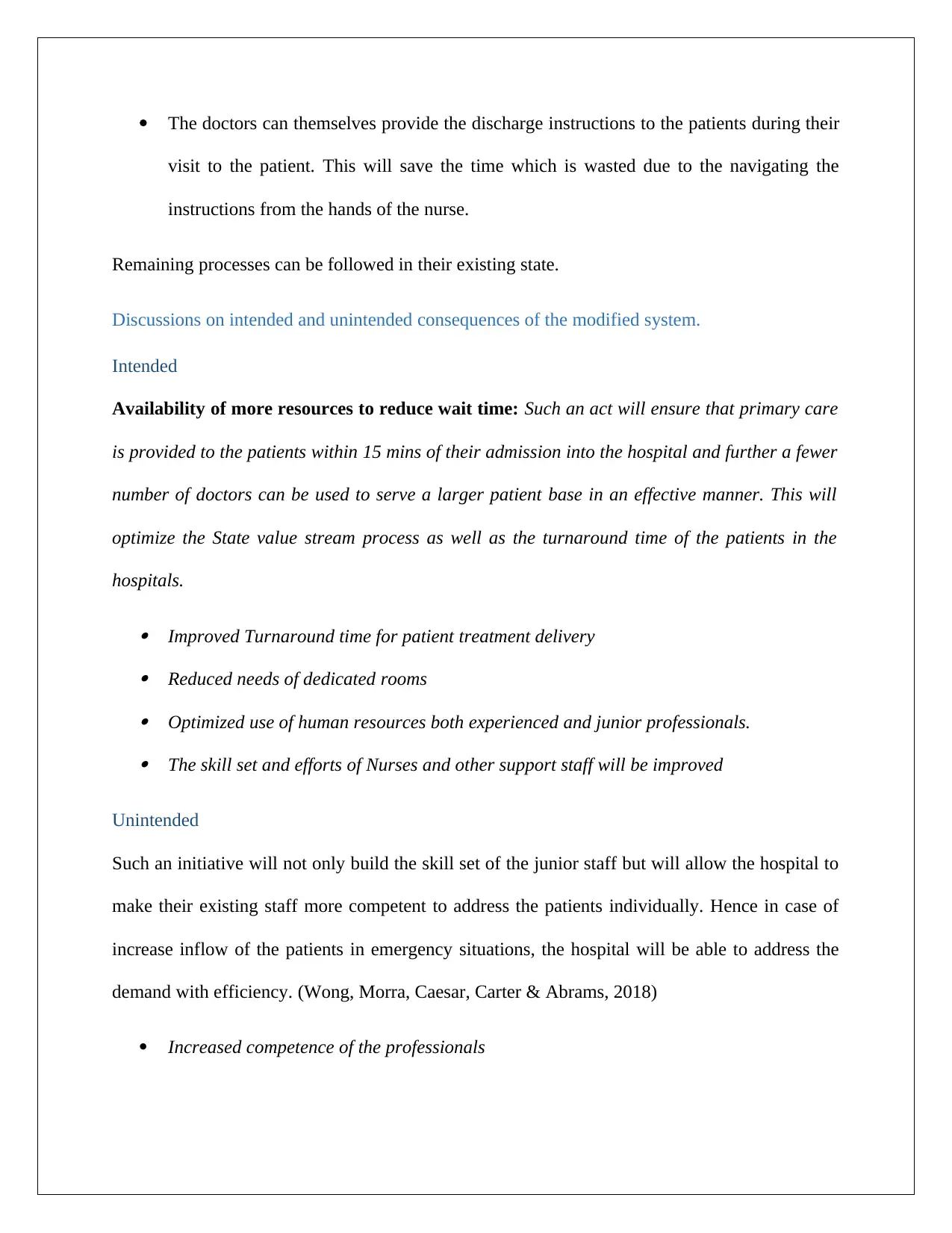
The doctors can themselves provide the discharge instructions to the patients during their
visit to the patient. This will save the time which is wasted due to the navigating the
instructions from the hands of the nurse.
Remaining processes can be followed in their existing state.
Discussions on intended and unintended consequences of the modified system.
Intended
Availability of more resources to reduce wait time: Such an act will ensure that primary care
is provided to the patients within 15 mins of their admission into the hospital and further a fewer
number of doctors can be used to serve a larger patient base in an effective manner. This will
optimize the State value stream process as well as the turnaround time of the patients in the
hospitals.
Improved Turnaround time for patient treatment delivery Reduced needs of dedicated rooms Optimized use of human resources both experienced and junior professionals. The skill set and efforts of Nurses and other support staff will be improved
Unintended
Such an initiative will not only build the skill set of the junior staff but will allow the hospital to
make their existing staff more competent to address the patients individually. Hence in case of
increase inflow of the patients in emergency situations, the hospital will be able to address the
demand with efficiency. (Wong, Morra, Caesar, Carter & Abrams, 2018)
Increased competence of the professionals
visit to the patient. This will save the time which is wasted due to the navigating the
instructions from the hands of the nurse.
Remaining processes can be followed in their existing state.
Discussions on intended and unintended consequences of the modified system.
Intended
Availability of more resources to reduce wait time: Such an act will ensure that primary care
is provided to the patients within 15 mins of their admission into the hospital and further a fewer
number of doctors can be used to serve a larger patient base in an effective manner. This will
optimize the State value stream process as well as the turnaround time of the patients in the
hospitals.
Improved Turnaround time for patient treatment delivery Reduced needs of dedicated rooms Optimized use of human resources both experienced and junior professionals. The skill set and efforts of Nurses and other support staff will be improved
Unintended
Such an initiative will not only build the skill set of the junior staff but will allow the hospital to
make their existing staff more competent to address the patients individually. Hence in case of
increase inflow of the patients in emergency situations, the hospital will be able to address the
demand with efficiency. (Wong, Morra, Caesar, Carter & Abrams, 2018)
Increased competence of the professionals
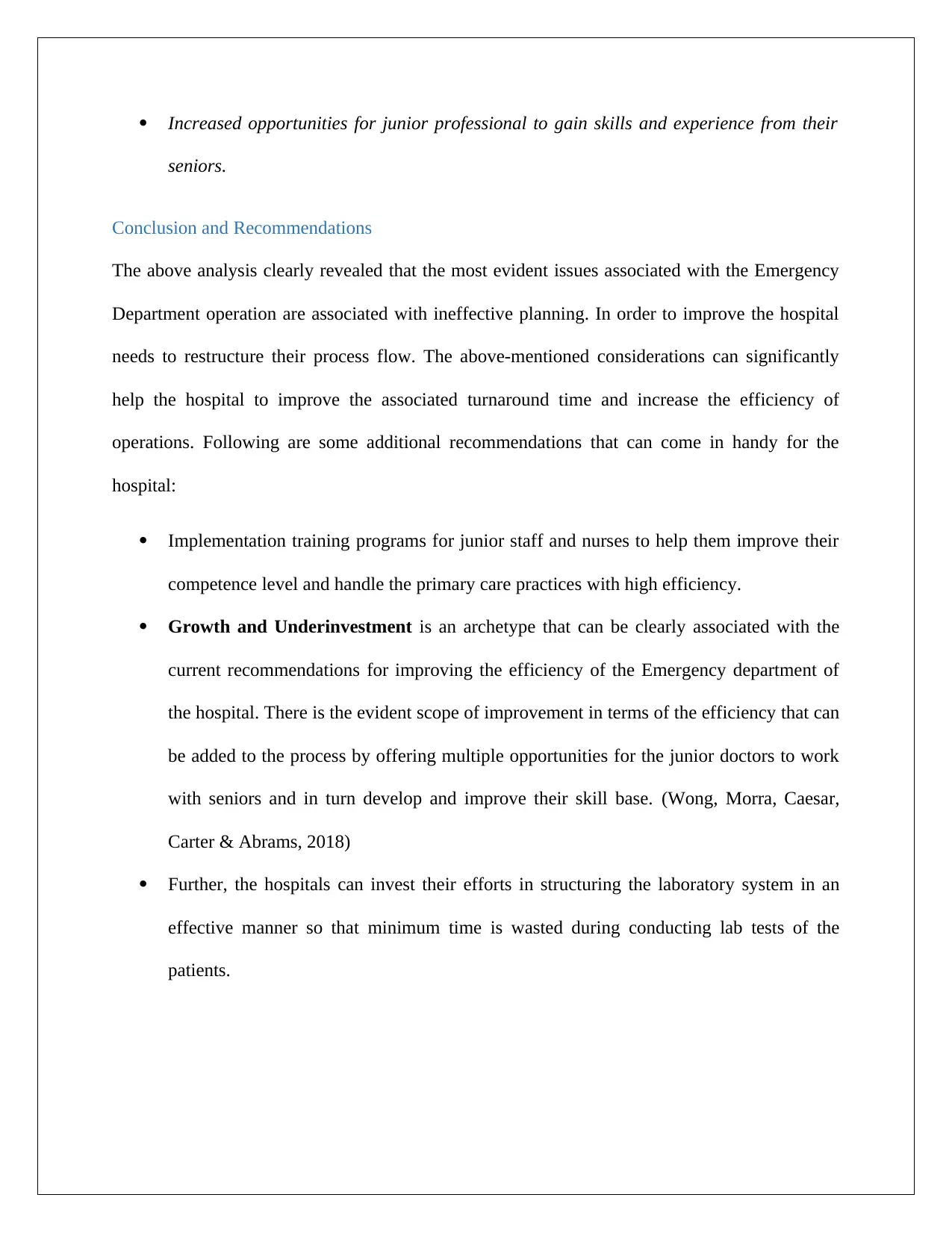
Increased opportunities for junior professional to gain skills and experience from their
seniors.
Conclusion and Recommendations
The above analysis clearly revealed that the most evident issues associated with the Emergency
Department operation are associated with ineffective planning. In order to improve the hospital
needs to restructure their process flow. The above-mentioned considerations can significantly
help the hospital to improve the associated turnaround time and increase the efficiency of
operations. Following are some additional recommendations that can come in handy for the
hospital:
Implementation training programs for junior staff and nurses to help them improve their
competence level and handle the primary care practices with high efficiency.
Growth and Underinvestment is an archetype that can be clearly associated with the
current recommendations for improving the efficiency of the Emergency department of
the hospital. There is the evident scope of improvement in terms of the efficiency that can
be added to the process by offering multiple opportunities for the junior doctors to work
with seniors and in turn develop and improve their skill base. (Wong, Morra, Caesar,
Carter & Abrams, 2018)
Further, the hospitals can invest their efforts in structuring the laboratory system in an
effective manner so that minimum time is wasted during conducting lab tests of the
patients.
seniors.
Conclusion and Recommendations
The above analysis clearly revealed that the most evident issues associated with the Emergency
Department operation are associated with ineffective planning. In order to improve the hospital
needs to restructure their process flow. The above-mentioned considerations can significantly
help the hospital to improve the associated turnaround time and increase the efficiency of
operations. Following are some additional recommendations that can come in handy for the
hospital:
Implementation training programs for junior staff and nurses to help them improve their
competence level and handle the primary care practices with high efficiency.
Growth and Underinvestment is an archetype that can be clearly associated with the
current recommendations for improving the efficiency of the Emergency department of
the hospital. There is the evident scope of improvement in terms of the efficiency that can
be added to the process by offering multiple opportunities for the junior doctors to work
with seniors and in turn develop and improve their skill base. (Wong, Morra, Caesar,
Carter & Abrams, 2018)
Further, the hospitals can invest their efforts in structuring the laboratory system in an
effective manner so that minimum time is wasted during conducting lab tests of the
patients.
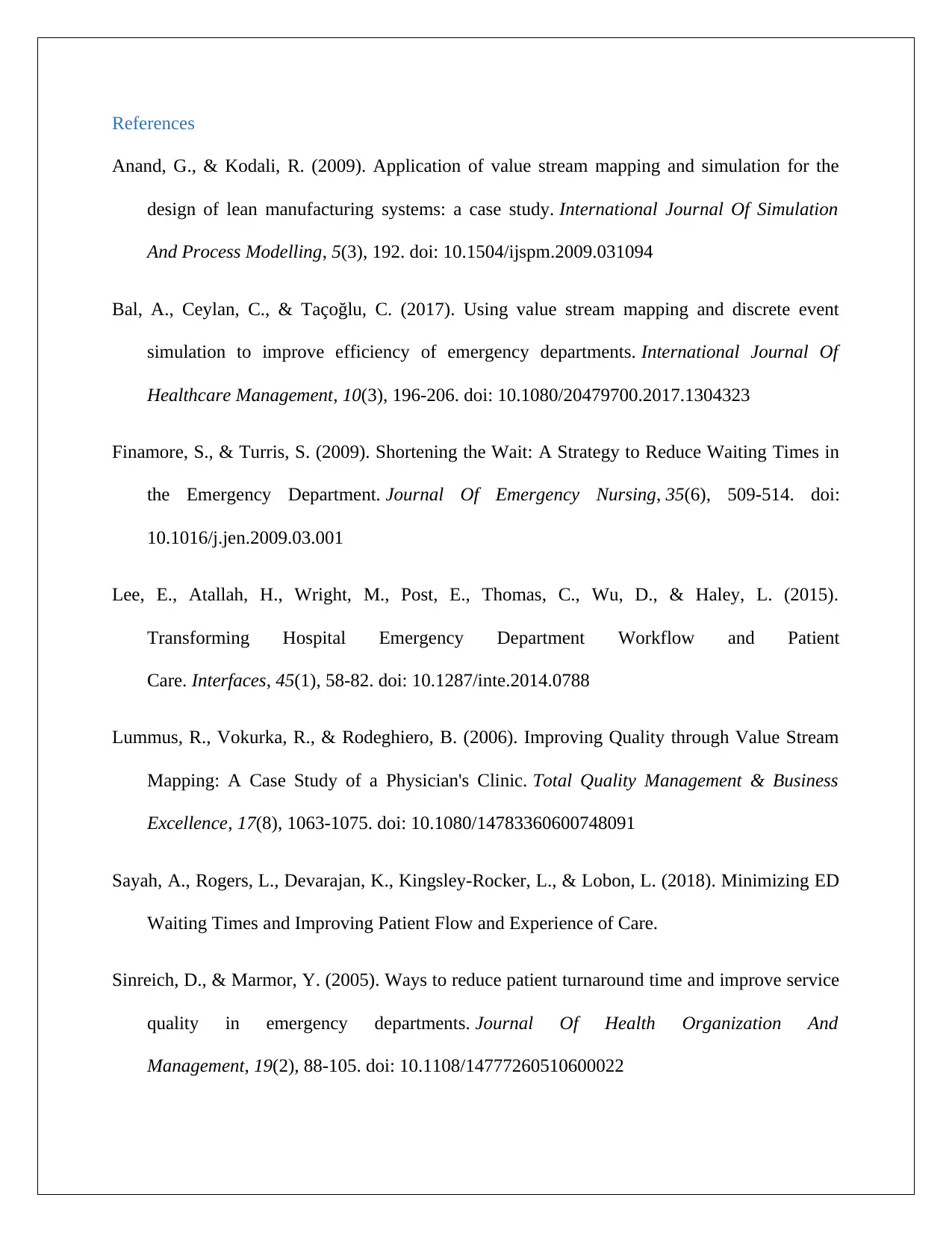
References
Anand, G., & Kodali, R. (2009). Application of value stream mapping and simulation for the
design of lean manufacturing systems: a case study. International Journal Of Simulation
And Process Modelling, 5(3), 192. doi: 10.1504/ijspm.2009.031094
Bal, A., Ceylan, C., & Taçoğlu, C. (2017). Using value stream mapping and discrete event
simulation to improve efficiency of emergency departments. International Journal Of
Healthcare Management, 10(3), 196-206. doi: 10.1080/20479700.2017.1304323
Finamore, S., & Turris, S. (2009). Shortening the Wait: A Strategy to Reduce Waiting Times in
the Emergency Department. Journal Of Emergency Nursing, 35(6), 509-514. doi:
10.1016/j.jen.2009.03.001
Lee, E., Atallah, H., Wright, M., Post, E., Thomas, C., Wu, D., & Haley, L. (2015).
Transforming Hospital Emergency Department Workflow and Patient
Care. Interfaces, 45(1), 58-82. doi: 10.1287/inte.2014.0788
Lummus, R., Vokurka, R., & Rodeghiero, B. (2006). Improving Quality through Value Stream
Mapping: A Case Study of a Physician's Clinic. Total Quality Management & Business
Excellence, 17(8), 1063-1075. doi: 10.1080/14783360600748091
Sayah, A., Rogers, L., Devarajan, K., Kingsley-Rocker, L., & Lobon, L. (2018). Minimizing ED
Waiting Times and Improving Patient Flow and Experience of Care.
Sinreich, D., & Marmor, Y. (2005). Ways to reduce patient turnaround time and improve service
quality in emergency departments. Journal Of Health Organization And
Management, 19(2), 88-105. doi: 10.1108/14777260510600022
Anand, G., & Kodali, R. (2009). Application of value stream mapping and simulation for the
design of lean manufacturing systems: a case study. International Journal Of Simulation
And Process Modelling, 5(3), 192. doi: 10.1504/ijspm.2009.031094
Bal, A., Ceylan, C., & Taçoğlu, C. (2017). Using value stream mapping and discrete event
simulation to improve efficiency of emergency departments. International Journal Of
Healthcare Management, 10(3), 196-206. doi: 10.1080/20479700.2017.1304323
Finamore, S., & Turris, S. (2009). Shortening the Wait: A Strategy to Reduce Waiting Times in
the Emergency Department. Journal Of Emergency Nursing, 35(6), 509-514. doi:
10.1016/j.jen.2009.03.001
Lee, E., Atallah, H., Wright, M., Post, E., Thomas, C., Wu, D., & Haley, L. (2015).
Transforming Hospital Emergency Department Workflow and Patient
Care. Interfaces, 45(1), 58-82. doi: 10.1287/inte.2014.0788
Lummus, R., Vokurka, R., & Rodeghiero, B. (2006). Improving Quality through Value Stream
Mapping: A Case Study of a Physician's Clinic. Total Quality Management & Business
Excellence, 17(8), 1063-1075. doi: 10.1080/14783360600748091
Sayah, A., Rogers, L., Devarajan, K., Kingsley-Rocker, L., & Lobon, L. (2018). Minimizing ED
Waiting Times and Improving Patient Flow and Experience of Care.
Sinreich, D., & Marmor, Y. (2005). Ways to reduce patient turnaround time and improve service
quality in emergency departments. Journal Of Health Organization And
Management, 19(2), 88-105. doi: 10.1108/14777260510600022
Paraphrase This Document
Need a fresh take? Get an instant paraphrase of this document with our AI Paraphraser
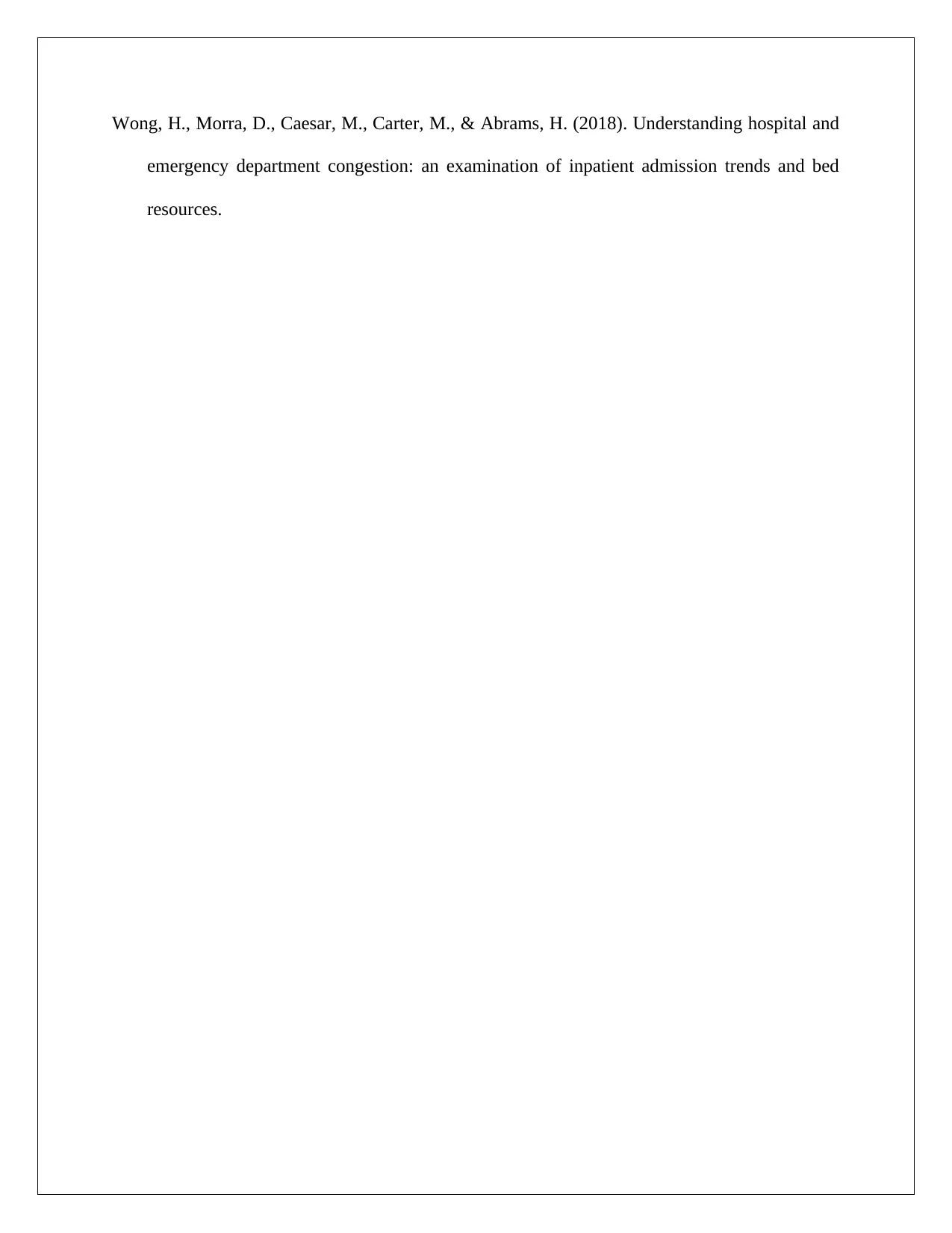
Wong, H., Morra, D., Caesar, M., Carter, M., & Abrams, H. (2018). Understanding hospital and
emergency department congestion: an examination of inpatient admission trends and bed
resources.
emergency department congestion: an examination of inpatient admission trends and bed
resources.
1 out of 14
Related Documents
Your All-in-One AI-Powered Toolkit for Academic Success.
+13062052269
info@desklib.com
Available 24*7 on WhatsApp / Email
![[object Object]](/_next/static/media/star-bottom.7253800d.svg)
Unlock your academic potential
© 2024 | Zucol Services PVT LTD | All rights reserved.




